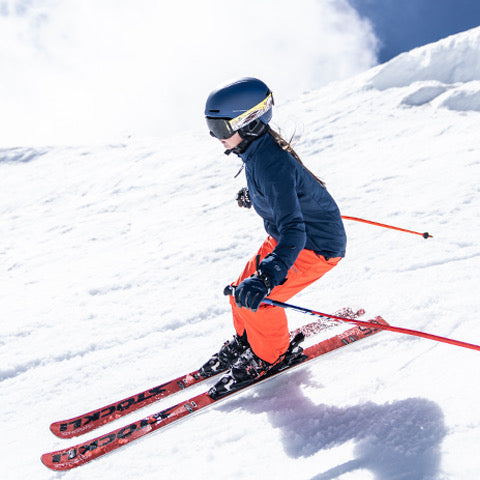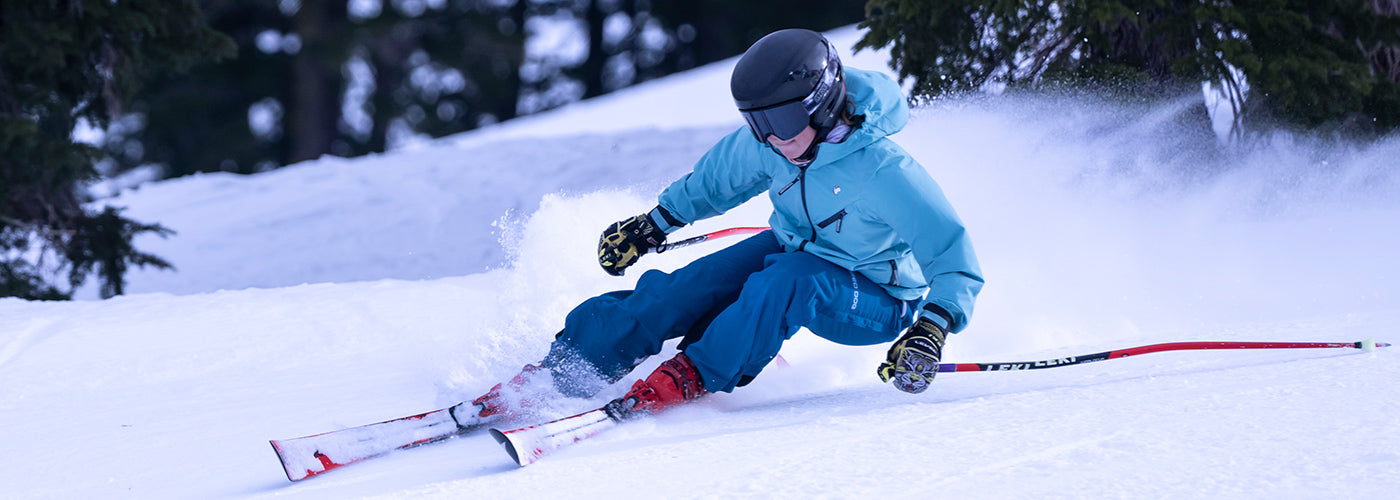Whether you call them insulated jackets, puff jackets, puffers, or something else, puffy jackets are a staple in any kids’ wardrobe and there is a wide range between the best kids puffy jackets, the average coat, and the lower quality options. So what makes the best kids puffy jacket? Before we can answer that question, one key factor is important to define: its intended use. More on that below but, for purposes of this article, at AKOVA, we set out to make the best kids’ puffy jacket for winter sports layering and versatile, standalone, year-round use. And with that goal in mind, our research and development team analyzed the myriad materials and technologies available to design what we believe to be the best insulated jacket for kids. Read on for a buyer's guide to use when evaluating any kids' puffy on the market.
The Challenges with Most Kids Puffy Jackets
Historically, children's puffy jackets provided warmth at the expense of a bulky silhouette or, the so called, “michelin man” look. In recent years, more brands have used thinner insulation but most still use the same amount of insulation throughout the jacket, regardless of where added warmth is most needed, leading to excessive bulk and reduced range of motion.
But the most significant challenges with most kids' puffers are twofold: one, they offer little to no stretch, and two, they typically feature a shiny, noisy, face fabric. The reason for both of these challenges is actually the same. Most insulation fibers, whether down or some synthetics will eventually migrate through the face fabric (think feathers in your bed pillow). Therefore, a face fabric with stretch would make that problem worse because, when it stretches, it creates openings for the fibers to escape. As a result, the shiny, noisy, exterior we’re all used to, is often a result of an exterior coating to the fabric intended to prevent insulation fibers from migrating through. We thought (and knew) there must be a better way.
Another challenge we found with most puffys for boys and girls was a lack of true thermo-regulating properties which, in layman’s terms, means the garment’s ability to help keep you warm when it’s cold but not overheated when you exert yourself or when the temperature rises. Breathability, as well as the right amount of insulation in the right places, were key factors in our analysis of how to design a better (the best) kids puffy jacket. We, as parents, were not satisfied with what was on the market and our goal was to improve upon that.
One Technology; A Game-Changer In Two Areas
In our research, we discovered Thermore's Freedom Insulation and found it to be perfect for kids’ insulated jackets. The secret lies in both the insulation's incredible stretch properties as well as its unique Fiber Migration Control.
What that means is not only will the insulation itself stretch (four times moreso than other insulation products on the market), but it can be paired with a face fabric that also has stretch without fear of the insulation fibers migrating through to the exterior. So the end result is not only a kids’ puffy jacket that actually stretches and provides better range of motion, but the face fabric can have a softer, more luxurious hand feel than the old-school, shiny, crunchy, treated face fabrics that most kids’ puffer jackets have used in the past.
Other Features That the Best Kids Puffy Jacket Should Include
For a piece to be considered the best kids’ puffy jacket on the market, perhaps solving the stretch, softer face fabric, and fiber migration issues would be enough. But for a truly versatile, year-round piece, that is also optimized for winter sports layering, there are a number of other features that we believe are important and, if missing, would result in a good jacket, but not the best kids’ insulated jacket.
Body-Mapped Insulation
When it comes to insulated puffy jackets, there are two truths: one, different input materials for different areas adds design complexity and cost, but two, the human body, even a kids’ body, simply does not need the same amount of insulation in all places. So to reduce bulk, improve overall fit and range of motion, and optimize thermo-regulation, it’s simple science to state that the best kids’ puffy jacket requires more insulation in the core and less insulation in the arms (sleeves). Therefore, the best jackets on the market for kids should have the right amount of insulation for the right area of the body.

Water-Resistant Exterior
A water-resistant exterior is a vital feature for any youth puffy jacket. While these insulated jackets are not designed to be fully waterproof like a ski shell or rain shell, when caught in light rain or snow, a durable water repellancy (DWR) treatment is what allows water droplets to bead up and roll off for a period of time. This is especially important for most down insulation products, given that most down loses its heat retention properties when wet unlike synthetics (more on that below). Whether with down insulation or synthetic, we believe any high-performance kids’ puffer needs to have an effective DWR.
Adjustable Sleeve-Length
One innovation seen with kids’ ski pants and kids’ ski jackets has been the advent of adjustable sleeve/pant lengths, given that kids’ outgrow their gear rapidly. While, on one hand, we believe, our Adjust-a-Fit™ system has improved on that capability for all ski outerwear, what we found was that no other brands incorporated a similar feature into puffy jackets for boys and girls. If you don’t need a high-performance puffy, maybe that’s okay, but when investing in a high quality product, we believe you should get more than one year out of it for your kids and be able to then hand it down to younger siblings.
Breathable, Stretch, Underarm Panels
Breathable, stretchy insulation, paired with a breathable, stretch face fabric is already a game-changer in kids’ puffy jackets. But after a couple seasons of improving on our designs, we also found that a simple panel, under the arms, made from a different, even more stretchy fleece material, dramatically improved range of motion and comfort and, now, we can’t imagine calling a jacket the “best kids’ puffy jacket” that does not have that feature.
Drop-Back Hem
The drop-back hem design is another feature that enhances the jacket's practicality. A drop-back hem is a feature where the back of a garment is intentionally longer than the front. It is crucial in cold and unpredictable weather conditions, especially when bending or sitting, that prevents the “gap” between the back and the waist that would allow cold air or moisture to reach the skin or under layers. While other brands do also incorporate this relatively simple feature, it is uncommon in the ones that offer a “3-in-1” jacket where the “liner” can be removed but always looks and feels more like a liner of something else, rather than a standalone, year-round, stylish jacket.

Enough Pockets
When it comes to kids’ puffy jackets, most on the market have exactly two pockets, one for each hand. Perhaps one interior pocket as well. While it’s wearer preference with regard to what is the perfect number of pockets, we believe the best youth puffy jacket should be a complete coat, whether worn under other layers or as a standalone, year-round piece. For our Kids’ Elevated Insulator, we included a total of 5 primary pockets (2 hand pockets, a zippered interior pocket, a stretch interior dump pocket, and a small, zippered, interior chest pocket), plus a forearm pass pocket for those kids that prefer to wear that piece as their outer layer when skiing or snowboarding in appropriate conditions to not need a hardshell layer.
Down Vs Synthetic
Generally speaking, down insulation is more expensive than synthetic, is warmer on a weight for weight basis, but does not hold its warmth properties when wet. That said, modern synthetics like Thermore’s Freedom insulation have come a long way in competing with down’s warmth properties. And, further, there are several down products on the market now that are far more water-resistant than down products of the past. More on this topic in a future article but for this context and the information above, our research showed that for this application, the use of Thermore Freedom synthetic insulation resulted in the best kids’ insulated jacket.
Conclusion: A Few Notes on Intended Use & Cost
As we implied in the beginning of this article, it is impossible to say what is the best kids’ puffy jacket without first defining its intended use. A jacket made for maximum warmth for primarily stationary activities is different than one made for snow sports like skiing and snowboarding that require stretch, range of motion, and thermo-regulation.. A lightweight, less expensive piece for casual, “low-performance” use is another. For our intended design, like we wrote above, we set out to make the best kids’ puffy jacket for winter sports layering, versatile year-round use, with a combination of warmth, style, and comfort.
Finally, there is a difference between “best” and “best at a certain price point.” Typically, especially when kids outgrow their jackets every year, parents are forced to choose between the “best” and the “best we can afford.” At AKOVA, our puffy jackets for kids, in particular our flagship Kids’ Elevated Insulator, are certainly not inexpensive. Quality gear is not inexpensive to make. But because we cut out the middleman markup of selling through retailers, we are able to use the best fabrics and technologies, and still price our items at a similar or lower price to the next best alternative on the market. In short, we did not set out to make a cheaper kids’ puffy jacket. We set out to make the best kids’ puffy jacket. And the only way we can make that still affordable is with features like Adjust-a-Fit to get more use out of the jacket and by eliminating the retail markup and selling directly to you.
Whether we succeeded in making the best kids’ puffy available or not is up to you. We hope this insight into our R&D and thought process will help you evaluate the alternatives you see on the market and allow you to find and purchase the best gear for your kids.








